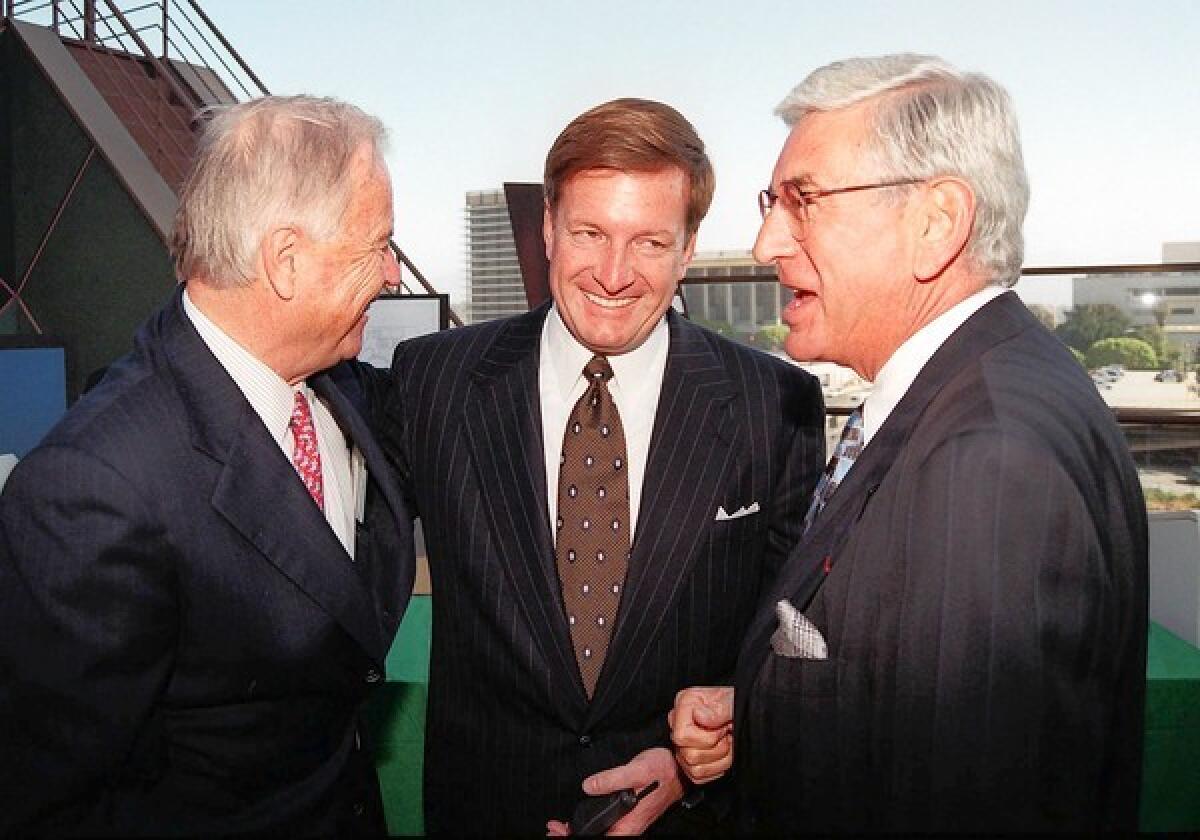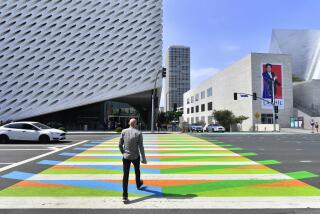Disney Hall: Musical dream bankrolled by taxpayers, private donors

Lillian Disney lived 101/2 years after instigating the creation of Walt Disney Concert Hall in her husband’s honor by donating $50 million, but she never got to see it rise from its foundation, alone attend a performance.
“A concert hall that would entertain the public with the finest musical offerings would be enormously gratifying to him,” she had said in announcing her gift in 1987. The groundbreaking ceremony launching Disney Hall’s construction finally arrived in December 1999 — two years after her death at age 98.
The project became an epic mess that was sorted out only after it had turned into a civic embarrassment. Delays and haggling over architecture, planning and legal protections for Los Angeles County and its taxpayers ate up time and money until they’d all but killed the project by the summer of 1994. Then-Mayor Richard Riordan and his friend Eli Broad led its resuscitation in 1996, less concerned about providing “the finest musical offerings” than with eliminating the stench of failure.
TIMELINE: Walt Disney Hall through the years
At that point, all backers had to show for Lillian Disney’s initial gift and the $116-million county bond issue that had gone primarily toward the concert hall’s underground parking garage was a concrete slab on the western side of Grand Avenue — the garage roof that was supposed to double as Disney Hall’s foundation.
The venue’s birth trauma sprang from the same cause as its eventual greatness. A routine symphony hall would have been easy. Frank Gehry’s design — chosen in 1988 after a competition among leading international architects — was so innovative that it raised serious doubts as to whether such an elaborately curved creation could even be built, let alone function for music.
Among those with the biggest worries were county officials, who had provided the land.
Months turned into years while the county and the volunteer-led corporation that had been set up to build Disney Hall haggled over the garage and the county’s concerns about potential shortfalls in private donations. Meanwhile, backers had drastically underestimated the fundraising challenge.
On the day that Lillian Disney announced her gift, the Music Center’s chairman, F. Daniel Frost, said her $50 million was expected to cover most of the hall’s construction cost. In the early 1990s, the estimate rose to $110 million, and to $210 million in 1994. The final price — not determined until contractors’ lawsuits over cost overruns were settled in 2006 — was $284 million from private donors and government sources, plus $4.5 million paid by Gehry’s insurers (although the architect was not held responsible for the overruns).
The woes became apparent when builders’ bids finally were received in 1994. After getting a look at Gehry’s curves, contractors estimated that it would cost at least $260 million to build.
The County Board of Supervisors responded by requiring that 95% of the private money be raised before work could proceed atop the garage. Everything froze, and Disney Hall became the latest setback for a city whose image and spirits already were suffering from the 1994 Northridge earthquake, the 1992 Rodney King riots and a rapid disappearance of high-paying jobs in defense industries.
In 1996, with the parking garage completed for $70.1 million and standing as a concrete symbol of failure, Riordan and Broad, a multibillionaire philanthropist and advocate for downtown L.A.’s revival, decided it was imperative for the city’s leadership class to turn the embarrassment into a proud accomplishment.
“Suddenly, Disney Hall was no longer about a symphony orchestra, the arts or even philanthropic generosity. It was about Los Angeles’ right to call itself a world-class city,” Broad recalled in his 2012 book, “The Art of Being Unreasonable: Lessons in Unconventional Thinking.”
As Broad, Riordan and a third key fundraiser, Music Center Chairman Andrea Van de Kamp, began reaching out to prospective contributors, two important things worked in their favor. Gehry’s Guggenheim Museum Bilbao in Spain, very similar to his Disney Hall concept, was well under way by then. Opening within its budget and to great acclaim in 1997, it dispelled fears about Disney Hall’s feasibility.
INTERACTIVE: Disney Hall inside and out
Meanwhile, U.S. investment markets were in an astonishing boom driven by technology stocks. It eventually went bust, but from January 1996 through late March 2000, when most of the Disney Hall fundraising took place, the S&P 500 stock price index rose 144%.
Disney family and corporate interests ultimately provided $135 million for construction and related design and engineering fees — 47% of the hall’s cost. Family members and their private foundations provided about $115 million, including $28 million in interest earnings that had accumulated from Lillian Disney’s original gift. The Walt Disney Co. gave $20 million for construction and a $5 million endowment for REDCAT, the theater and gallery operated in the concert hall by the California Institute of the Arts.
The second-biggest contributors were the taxpayers of Los Angeles County. According to the county Chief Executive’s Office, $30.6 million from the bond issue that had mainly funded the parking garage was funneled toward Disney Hall’s construction.
The biggest non-Disney private donors were Eli and Edythe Broad and the now-defunct Arco Foundation, at $10 million each. Ron Burkle was responsible for $15 million, divided evenly between a personal contribution and funding from the Ralphs/Food 4 Less Foundation, which handled corporate giving for the supermarket chains he owned at the time.
Disney Hall has been an economic as well as artistic boon to the Los Angeles Philharmonic, whose leaders have credited ongoing excitement over the building and its superb acoustics with helping it vastly improve its own fortunes after a series of deficits that had seriously eroded its financial position in the late 1990s. The Phil now is seen as one of the nation’s leading orchestras, both financially and in artistic accomplishment and ambition.
More to Read
The biggest entertainment stories
Get our big stories about Hollywood, film, television, music, arts, culture and more right in your inbox as soon as they publish.
You may occasionally receive promotional content from the Los Angeles Times.







